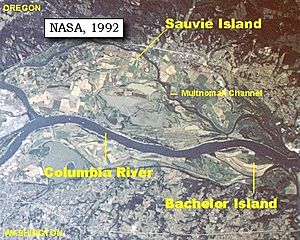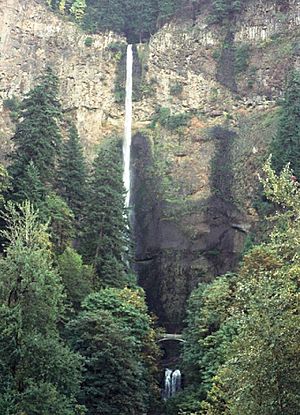Multnomah people facts for kids
The Multnomah are a group of Chinookan people. They used to live near what is now Portland, Oregon, in the United States. Their villages were spread across the Portland area and on both sides of the mighty Columbia River. The Multnomah spoke a special kind of the Upper Chinookan language. This language belongs to a bigger group called Oregon Penutian.
Contents
A Look Back: Multnomah History
The Multnomah people were part of the larger Chinookan peoples. They lived mainly on and around Sauvie Island in Oregon. The Multnomah and their relatives, the Clackamas tribes, had many villages. These villages were located along the Columbia River, especially near where the Willamette River flows into it. In the early 1800s, the Willamette River was sometimes even called the "Multnomah River."
Experts who study old civilizations, called archaeologists, believe these villages were home to about 3,400 people all year long. During fishing season and when they harvested a plant called wappato, the population could grow to 8,000! Wappato is a marsh plant that grows like a potato or onion, and it was a very important food for them.
Sadly, in 1830, a terrible sickness, probably malaria, hit the Multnomah villages very hard. Within just five years, one big village called Cathlapotle was empty. By 1834, most of the Multnomah people were gone because of malaria and smallpox. By 1910, only a few Multnomah people were left. They moved to the Grand Ronde Community, which is also in Oregon.
Where Did the Multnomah Live?
In 1854, Multnomah County became an official part of Oregon. The Multnomah people lived in this area, especially on Sauvie Island in the Columbia River. The Native Americans called Sauvie Island "Wappatoo Island." The Multnomah shared Sauvie Island with other Chinook tribes. Together, they were sometimes called "The Cathlascans." The Multnomah were known as "upper Chinook" and spoke the Wasco-Wishram language.
One of their larger villages, Cathlapotle, was in what is now Clark County, Washington. It was located where the Lewis River meets the Columbia River. The famous Lewis and Clark Expedition visited this village in 1805. Their journals say they found 14 houses there. Most of these houses were quite large, some up to 40 feet wide and 100 feet long! They wrote that about 900 people lived in these villages. Another group of Multnomah, called the Cathlacomatup, lived along the Multnomah Channel. Lewis and Clark also met them in 1805.
The Story of Chief Multnomah
The Multnomah people are named after their great leader, Chief Multnomah. For a long time, people wondered if he was a real person or just a legend. Other Native American tribes in the Columbia River Valley talked about him in their stories passed down through generations. However, some historians in Oregon thought he was just a myth.
Luckily, there is evidence that he was real! Besides the spoken stories, there were old newspapers and journals that mentioned him. The Oregon Historical Society had presidents who doubted his existence, but many written accounts suggest he was indeed a real chief.
Chief Multnomah was said to be a powerful leader. He ruled tribes across a large area of the Pacific Northwest, from Oregon all the way to Canada. For 40 years, he was chief of the Willamettes and a war chief for tribes and communities near Wauna, Oregon. His main base was on what we now call Sauvie Island.
A history professor named Ann Fulton from Portland State University found many written stories about Chief Multnomah. She wrote about her findings in a paper called The Restoration of an Iłkák'mana: A Chief Called Multnomah. She wanted more people to know about him. People like William Tappan and Dr. Elijah White, who worked with Indian tribes, wrote about him. Many of these stories, both spoken and written, described Chief Multnomah in similar ways. He was highly respected, known as a strong warrior chief who was also very admired by his people.
It's believed that Chief Multnomah's time as leader ended around the 1780s, possibly after Mount Hood erupted. In 1792, Captain George Vancouver and his crew explored the area but didn't mention meeting Chief Multnomah. However, in 1805, when Lewis and Clark reached Sauvie Island, they wrote about the "mulknomah" people. This name referred to Chief Multnomah and the groups of tribes he led.
Multnomah Culture and Daily Life
The homes of the Multnomah people, like other Chinookan peoples, were mostly longhouses. These large houses were built from planks of Western Redcedar wood. The size of a home depended on how wealthy the owner was. The biggest houses could hold up to 100 people! Inside, each family had its own private space, separated by woven mats. Every family had its own small fire, but they also shared a larger fire in the middle of the longhouse.
The Multnomah diet was rich and varied. They ate lots of salmon, eels, and sturgeon from the rivers. They also hunted elk and many kinds of water birds. A very important part of their diet was wapato, the marsh plant that was like a potato.
Fascinating Multnomah Legends
How the Land and Name Came to Be
One old story tells how the Multnomah people got their name. It's about a disagreement between two brothers.
The Great Spirit, who had no physical form, watched over all the people in the world. Everyone was happy, except for two brothers. The Great Spirit took the brothers to the top of a mountain. From there, they could see all their land. He told each brother to shoot an arrow in a different direction. The Great Spirit said that each brother could claim the land where his arrow landed and become chief there.
What we now call the Columbia River became the border between the two brothers' lands. The first brother's arrow landed in the Willamette Valley. He became Chief Multnomah of the Multnomah people. The second arrow landed north of the river, in what is now Klickitat County. He became chief of the Klickitat people.
The Legend of Multnomah Falls
According to a Wasco tribe legend, the daughter of Chief Multnomah made a great sacrifice. She threw herself from the top of Multnomah Falls to the Great Spirit. Tribes along the Columbia River were celebrating the marriage of the Chief's daughter to a chief from a nearby tribe. But their happiness didn't last. A terrible sickness spread through all the tribes along the river.
The medicine man said that the Great Spirit told him everyone would die unless the Chief's daughter gave her life. The Chief did not want his daughter to do this. But when the daughter saw her loved ones getting sick, she bravely left in the middle of the night. She went to the top of the cliff overlooking the Columbia River and jumped off. When the Chief found his daughter's body, he prayed to the Great Spirit for a sign that her spirit was safe. Water then began to pour from the cliff, and it became known as Multnomah Falls.
The Multnomah People Today
Most of the Multnomah people who are alive today live in the Grand Ronde Federation and Warm Springs Indian Reservation. However, the Multnomah no longer exist as a separate, distinct tribe.
The Name "Multnomah" Lives On
Many places in the Pacific Northwest are named after the Multnomah people. Multnomah County gets its name from this Native American word. You can also find the name in places like the Multnomah Athletic Club, Multnomah Falls, Multnomah Village, and even a statue of Chief Multnomah in a Portland park.
Artwork Honoring the Multnomah
In Portland, Oregon's Washington Park, there is a statue of Chief Multnomah called Coming of the White Man. This bronze statue was put up in 1904 by a sculptor named Hermon Atkins MacNeil. He was inspired by a popular book called Bridge of the Gods: A Romance of Indian Oregon. This book took stories MacNeil heard from Native Americans and made them into a grand tale.
The statue shows two Native American men looking east along the Oregon Trail. They are looking down on the path where settlers, pulled by ox teams, traveled to the western United States. The older man in the statue is believed to be Chief Multnomah. The statue was given to the city of Portland by the family of David P. Thompson. MacNeil also made smaller statuettes of Chief Multnomah.
The idea and name for this sculpture came from Meriwether Lewis and William Clark's journey across the United States. In 1805, when they arrived in Oregon, Lewis and Clark found a village. They described the Native Americans living there as "mulknomahs" on Sauvie Island. They even first called the Willamette River the "Mulknoma."
Chief Multnomah was also shown on linen postcards made between 1930 and 1945. He is pictured in colorful, traditional clothing. One of these prints is now part of The Tichnor Brothers Collection at the Boston Public Library. It's part of a series of postcards about Oregon and was published by Angelus Commercial Studio in Portland, Oregon.
Images for kids







